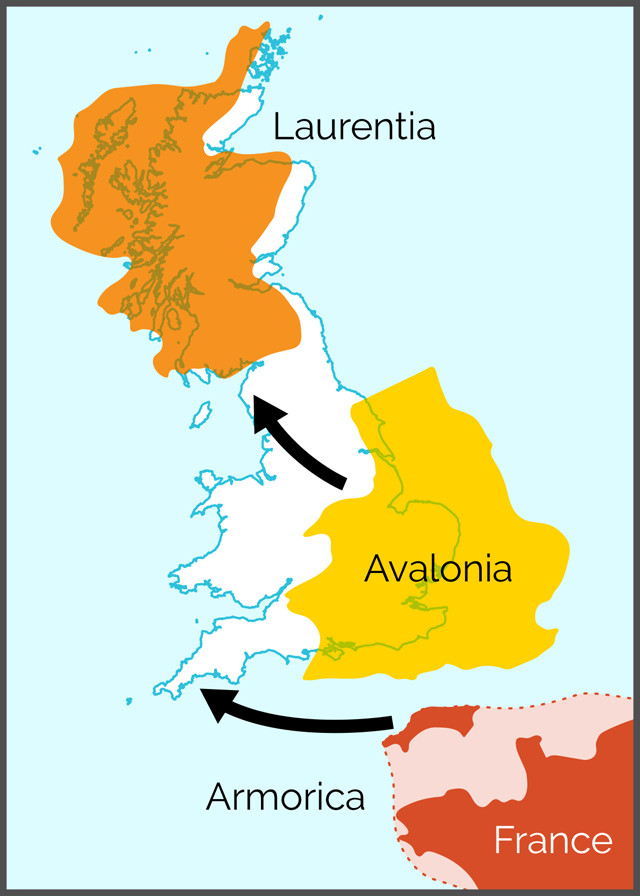
by Mary Caperton Morton Friday, December 21, 2018

The ancient landmasses of Laurentia, Avalonia and Armorica collided 400 million years ago, contributing pieces to the island that is today Great Britain. Credit: K. Cantner, AGI.
Great Britain is famously considered the birthplace of modern geology, and the many layers and terranes of rocks that make up England, Wales and Scotland have been studied and mapped for centuries. But that doesn’t mean scientists fully understand the island’s geologic past. In a new study, researchers looking at unusual volcanic rocks in southern England found previously unrecognized evidence of the island nation’s past connection to mainland Europe.
Cornwall, in southwest England, is known for its rich mineral deposits, especially tin and tungsten, which are found in France and elsewhere in mainland Europe, but nowhere else in Great Britain. The region is also studded with unusual volcanic rocks called lamprophyres that form dikes and small intrusions, bringing samples of the deep lithosphere closer to the surface. Arjan Dijkstra and Callum Hatch, geologists at the University of Plymouth in England, collected samples of these volcanic rocks from several quarries, thinking the intrusions might provide a glimpse of the lithospheric base beneath England and clues about where these deep rocks originated.
The pair studied the chemistry and isotopic signatures of the lamprophyre samples. “As the results came in, it quickly became clear that these rocks are very different from the rest of England in terms of their isotopic geochemistry,” Dijkstra says. “In fact, they’re a perfect match for the basement rocks in France, directly across the English Channel.” They reported the findings in Nature Communications.
About 400 million years ago, as the supercontinent Pangea was forming, collisions among landmasses were triggering mountain-building episodes all over the world. During this period, the landmasses Laurentia and Avalonia collided, raising the Caledonian Mountains between what are now Scotland (a leftover fragment of Laurentia) and England (a fragment of Avalonia). This two-part picture has long been the prevailing model for Britain’s geologic underpinnings. “Other studies have noted some mild metamorphism and deformation in southern England that might have come from a collision with a third landmass, but we hadn’t found clear evidence yet that a piece of this landmass had remained with England after the collision,” Dijkstra says.
The third landmass, Armor-ica, is known from previous studies to have broken off the ancient supercontinent of Gondwana (present-day Africa) as a microcontinent that today makes up France, Spain and middle Europe. Dijkstra and Hatch’s study suggests that the mineral-rich, southwesternmost part of England is a residual piece not of Avalonia, but of Armorica, with the boundary between the two terranes running from Camelford in the west, across parts of Cornwall and Devon, to the estuary of the River Exe in the east. The lamprophyres the researchers studied were hidden under layers of younger Devonian rocks, which “explains why nobody has found these foreign rocks before,” Dijkstra says.
Making such a discovery in well-studied Great Britain is no small feat, says Brendan Murphy, a structural geologist at St. Francis Xavier University in Nova Scotia, Canada, who was not involved in the new study. “Geologists have been documenting the tiniest details of this region’s geology for hundreds of years,” he says. “This paper draws upon that wealth of knowledge by asking some very insightful questions [about the lamprophyres of southern Britain] in very innovative ways.”
In addition to the similarities seen between the rocks in southwest England and in France, Murphy says there may be parallels between Armorica and rocks in Nova Scotia, as the two landmasses would have been neighbors before the opening of the Atlantic Ocean. “We have terrain in southern Nova Scotia that is very similar to the terrain of Armorica. They may both be derived from the same part of Africa. That could be an avenue for future study.”
Dijkstra says he expects to stir up some controversy with the new findings. “We like to think we have our house in order in Great Britain,” he says, so anything that challenges the established model is subject to skepticism.
Murphy, for one, thinks the work will inspire interesting follow-up studies. “This will probably set off something of a domino effect, as other people go back and look in their data for evidence of Armorica,” he says. “I expect we’ll be hearing more about this region in the next few years.”
© 2008-2021. All rights reserved. Any copying, redistribution or retransmission of any of the contents of this service without the expressed written permission of the American Geosciences Institute is expressly prohibited. Click here for all copyright requests.